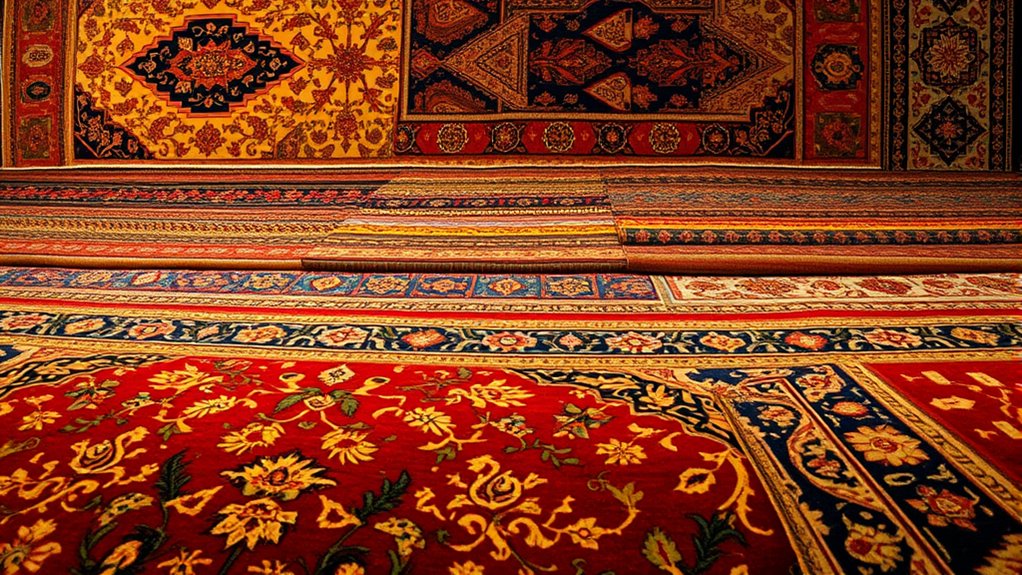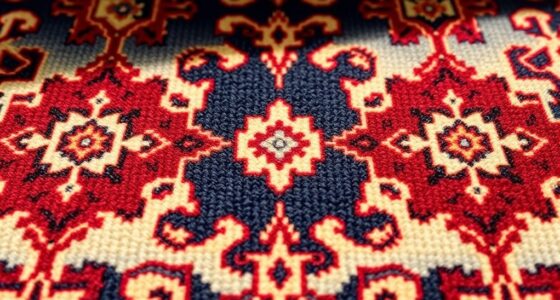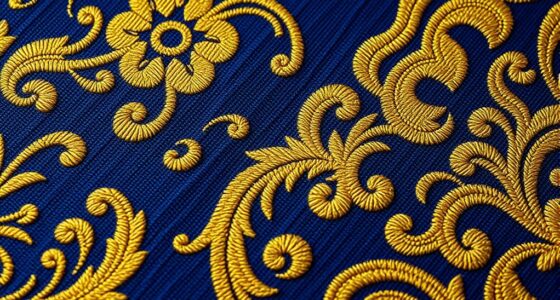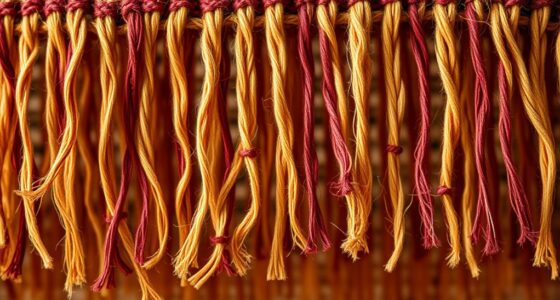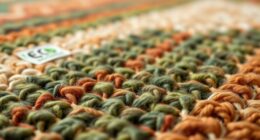Over the past three centuries, rug making has evolved through key movements: early traditions in the 17th-18th centuries established regional designs with natural dyes and refined knotting techniques. In the 19th century, Persian and Ottoman influences introduced intricate motifs and luxurious materials. The 20th century saw European adaptations, synthetic dyes, and technological advances, while the 21st century blends traditional craftsmanship with modern, eco-friendly innovations. Continuing this journey reveals even more about how history shaped today’s stunning rugs.
Key Takeaways
- Early 17th-18th centuries: rug traditions formed with regional motifs, natural dyes, and refined knotting techniques.
- 19th century: Persian and Ottoman influences introduced intricate designs, rich colors, and complex weaving styles.
- 19th-20th centuries: industrialization and exports led to larger formats, synthetic dyes, and global design exchanges.
- 20th century: digital weaving, eco-friendly fibers, and fusion of traditional and contemporary styles advanced rug-making.
- 21st century: revival of craftsmanship with eco-conscious materials and innovative techniques blending tradition with modern art.
Early Rug Traditions and Origins (17th-18th Century)
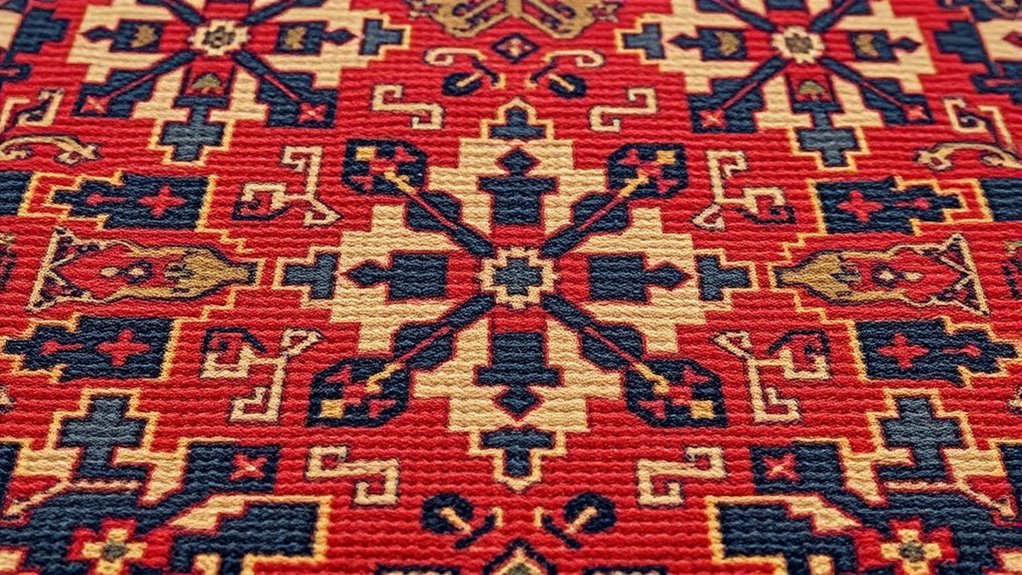
During the 17th and 18th centuries, rug-making traditions began to take shape across various regions, laying the groundwork for future designs. You notice that knotting techniques during this period became more refined, with artisans experimenting with different styles like the symmetrical and asymmetrical knots. These innovations allowed for more intricate patterns and durability. Knotting techniques evolved to include a variety of methods that enhanced both the aesthetics and stability of the rugs. Dyeing methods also advanced, as natural dyes derived from plants, minerals, and insects produced richer, more lasting colors. You’ll see that the combination of skilled knotting and improved dyeing contributed to the development of distinctive regional styles. Additionally, the use of materials like wool and silk became more prominent, enhancing both the texture and longevity of the rugs. The selection of regional motifs reflected local cultural influences and craftsmanship, further enriching the diversity of early rug designs. Moreover, the development of dyeing techniques allowed artisans to achieve more nuanced and vibrant color palettes that distinguished different regions and periods. Innovations in weaving tools also played a role in increasing the efficiency and quality of rug production during this era.
The Rise of Persian and Ottoman Influences (19th Century)
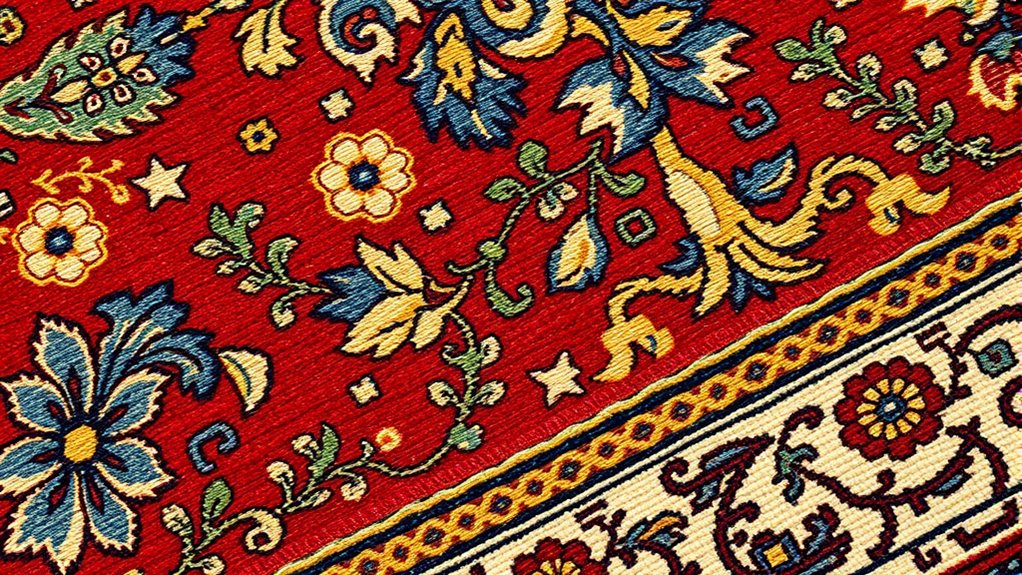
As the 19th century unfolded, Persian and Ottoman rug traditions gained prominence and influence across a broader region. Persian craftsmanship elevated with intricate designs, rich color palettes, and fine weaving techniques, making Persian rugs highly sought after. Meanwhile, Ottoman aesthetics introduced bold motifs, geometric patterns, and luxurious materials, reflecting imperial tastes. These influences spread beyond their origins, shaping regional styles and inspiring local weavers. You’ll notice the blending of detailed Persian artistry with the grandeur of Ottoman design in many rugs from this period. This era marked a shift toward more elaborate, refined pieces that demonstrated technical skill and cultural prestige. The rise of Persian and Ottoman influences cemented their roles as key players in shaping the diverse tapestry of 19th-century rug artistry. The development of weaving techniques during this period also contributed to the increased complexity and sophistication of rug designs. Additionally, the exchange of design motifs between cultures led to innovative patterns and decorative elements, further enriching the artistic landscape of the time. These exchanges were facilitated by international trade routes, which expanded the reach of both Persian and Ottoman textiles. The period also saw a rise in technological advancements, which improved production quality and enabled more intricate designs. Moreover, increased market demand for these styles encouraged artisans to experiment with new methods and motifs.
European and Colonial Adaptations (19th-20th Century)
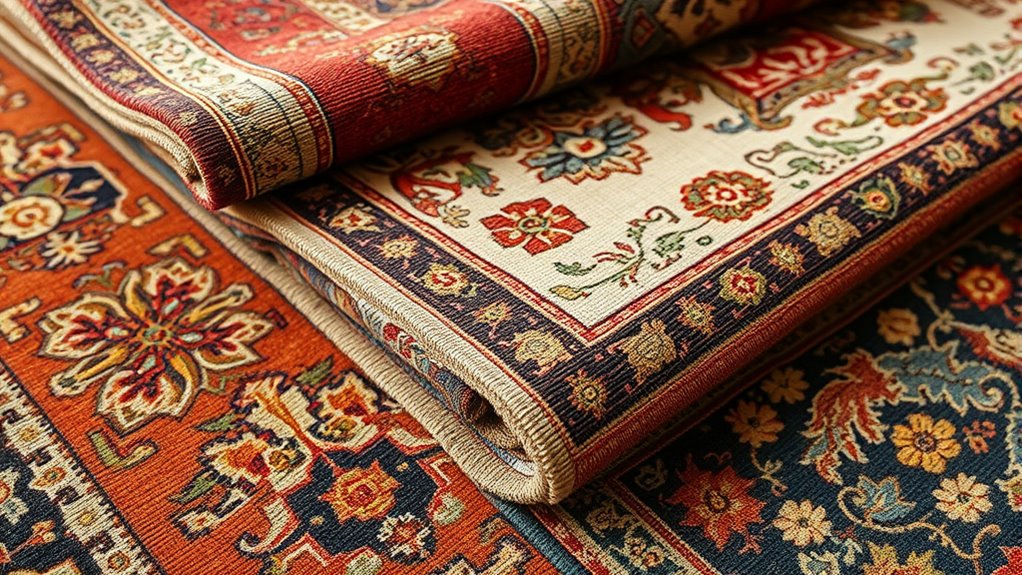
European and colonial markets deeply influenced rug design and production from the 19th into the 20th century. You’ll notice how weaving techniques became more diverse, combining traditional handcrafts with industrial methods to increase efficiency. These adaptations allowed for intricate patterns and larger formats, appealing to Western tastes. Dyeing methods also evolved, with synthetic dyes replacing natural ones, offering brighter, more consistent colors. This shift changed the aesthetic qualities of rugs, making them more vibrant and durable. European traders and colonial powers introduced new motifs and standards, blending local styles with imported designs. As a result, rugs from this period reflect a mixture of cultural influences and technological innovations, marking a significant transformation in the global rug industry.
Modern Innovations and Global Fusion (20th Century)

The 20th century brought rapid technological advances and increased global interaction that transformed rug design and production. Digital weaving emerged as a game-changer, allowing for intricate patterns and precise craftsmanship driven by computer technology. This innovation expanded creative possibilities and made complex designs more accessible. Alongside this, there was a strong shift toward sustainable fibers, with producers embracing materials like organic cotton, hemp, and recycled wool to reduce environmental impact. Modern innovations also influenced bathroom design, encouraging the integration of durable and innovative materials. Global fusion also played a role, blending traditional motifs with contemporary styles from diverse cultures. Additionally, the adoption of resilient fibers contributed to the durability and longevity of modern rugs. The use of organic and natural fibers in rug production gained popularity for their eco-friendly qualities and health benefits. Incorporating these fibers required advancements in fiber preservation methods to maintain quality during production. You’ll notice how these innovations fostered a new era of versatility and sustainability in rug making, reflecting both technological progress and a growing awareness of ecological responsibility. This period set the stage for further evolution in design and production techniques.
Contemporary Artistry and Revival Movements (21st Century)

In the 21st century, rug artistry experiences a vibrant resurgence rooted in both innovation and tradition. Artists are embracing digital weaving techniques, allowing for intricate designs and complex patterns that were previously difficult to achieve. This technology expands creative possibilities while maintaining craftsmanship. At the same time, there’s a strong movement toward sustainable textiles, with makers prioritizing eco-friendly materials like organic wool, hemp, and recycled fibers. This focus reflects a global desire to reduce environmental impact and promote ethical production. Contemporary artisans blend centuries-old techniques with modern innovation, creating unique pieces that honor tradition while pushing boundaries. This fusion of modern technology and traditional craftsmanship fosters a more dynamic and expressive rug industry. As a result, the rug world becomes more dynamic, expressive, and environmentally conscious, attracting new collectors and enthusiasts alike. Additionally, regional art movements influence design trends and inspire new styles in contemporary rug making. Retail hours can influence the availability of supplies and workshops for aspiring rug makers.
Frequently Asked Questions
How Did Trade Routes Influence Rug Design Evolution Over Centuries?
Trade routes greatly shaped rug design evolution over centuries by connecting diverse cultures and fostering textile innovation. As you follow these routes, you’ll notice how local motifs blend with foreign influences, creating unique patterns. Trade allowed for the exchange of techniques, dyes, and materials, which led to more intricate and vibrant designs. This ongoing interaction continuously enriched rug artistry, making it a reflection of global cultural exchange and technological advancement.
What Role Did Technology Play in Modern Rug Production?
Technology acts as the brush painting a new chapter in rug making. You harness digital weaving, which streamlines complex patterns with precision, and synthetic dyes, offering vibrant, consistent colors. These innovations turn traditional craftsmanship into a symphony of efficiency and creativity, allowing you to produce rugs faster and more colorfully. As a result, modern techniques elevate your artistry, blending age-old skills with cutting-edge tools to redefine the art of rug production.
Which Cultures Have Had the Most Lasting Impact on Rug Aesthetics?
You see, cultures like Persian, Turkish, and Chinese have had the most lasting impact on rug aesthetics. Their rich cultural influences shape the aesthetic evolution of rugs, blending intricate patterns, vibrant colors, and unique motifs. These traditions continue to influence modern designs, reflecting centuries of artistic expression. By understanding these cultural influences, you can appreciate how they’ve shaped the timeless beauty and diversity of rug styles worldwide.
How Do Contemporary Artists Reinterpret Traditional Rug Motifs?
Contemporary creators conquer the canvas by creatively reimagining traditional rug motifs, blending bold brushstrokes with modern motif reinterpretation. They use innovative techniques like digital design and mixed media to meld history with modernity, transforming timeless patterns into trendy tokens. You’ll see classic symbols subtly shift, sparking fresh perspectives. These artists challenge conventions, crafting mesmerizing, contemporary artworks that celebrate heritage while pushing boundaries with contemporary artistic techniques.
What Are the Environmental Impacts of Modern Rug Manufacturing?
You should consider that modern rug manufacturing impacts the environment through its ecological footprint, but sustainable sourcing helps guarantee this. By choosing eco-friendly materials and ethical production methods, you can lower pollution, conserve resources, and minimize waste. Opting for companies committed to sustainability not only benefits the planet but also ensures your rug aligns with eco-conscious values, making your purchase both stylish and responsible.
Conclusion
As you explore the centuries of rug-making, you’ll discover a tapestry as rich and intricate as a finely woven masterpiece. From ancient traditions to modern innovations, each movement adds a unique thread to the fabric of history. Just like a skilled weaver blending vibrant colors, today’s artisans continue to revive and transform these traditions. Embrace this journey, and you’ll see how each rug tells a story as timeless and enthralling as a well-worn heirloom.
